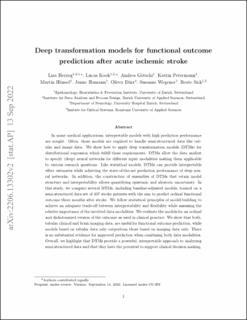Please use this identifier to cite or link to this item:
https://doi.org/10.21256/zhaw-27393Full metadata record
| DC Field | Value | Language |
|---|---|---|
| dc.contributor.author | Herzog, Lisa | - |
| dc.contributor.author | Kook, Lucas | - |
| dc.contributor.author | Götschi, Andrea | - |
| dc.contributor.author | Petermann, Katrin | - |
| dc.contributor.author | Hänsel, Martin | - |
| dc.contributor.author | Hamann, Janne | - |
| dc.contributor.author | Dürr, Oliver | - |
| dc.contributor.author | Wegener, Susanne | - |
| dc.contributor.author | Sick, Beate | - |
| dc.date.accessioned | 2023-03-20T13:42:44Z | - |
| dc.date.available | 2023-03-20T13:42:44Z | - |
| dc.date.issued | 2022-12-09 | - |
| dc.identifier.issn | 0323-3847 | de_CH |
| dc.identifier.issn | 1521-4036 | de_CH |
| dc.identifier.other | arXiv:2206.13302 | de_CH |
| dc.identifier.uri | https://digitalcollection.zhaw.ch/handle/11475/27393 | - |
| dc.description.abstract | In many medical applications, interpretable models with high prediction performance are sought. Often, those models are required to handle semistructured data like tabular and image data. We show how to apply deep transformation models (DTMs) for distributional regression that fulfill these requirements. DTMs allow the data analyst to specify (deep) neural networks for different input modalities making them applicable to various research questions. Like statistical models, DTMs can provide interpretable effect estimates while achieving the state-of-the-art prediction performance of deep neural networks. In addition, the construction of ensembles of DTMs that retain model structure and interpretability allows quantifying epistemic and aleatoric uncertainty. In this study, we compare several DTMs, including baseline-adjusted models, trained on a semistructured data set of 407 stroke patients with the aim to predict ordinal functional outcome three months after stroke. We follow statistical principles of model-building to achieve an adequate trade-off between interpretability and flexibility while assessing the relative importance of the involved data modalities. We evaluate the models for an ordinal and dichotomized version of the outcome as used in clinical practice. We show that both tabular clinical and brain imaging data are useful for functional outcome prediction, whereas models based on tabular data only outperform those based on imaging data only. There is no substantial evidence for improved prediction when combining both data modalities. Overall, we highlight that DTMs provide a powerful, interpretable approach to analyzing semistructured data and that they have the potential to support clinical decision-making. | de_CH |
| dc.language.iso | en | de_CH |
| dc.publisher | Wiley | de_CH |
| dc.relation.ispartof | Biometrical Journal | de_CH |
| dc.rights | https://creativecommons.org/licenses/by/4.0/ | de_CH |
| dc.subject | Deep learning | de_CH |
| dc.subject | Distributional regression | de_CH |
| dc.subject | Ordinal regression | de_CH |
| dc.subject | Transformation model | de_CH |
| dc.subject | Statistics | de_CH |
| dc.subject | Application | de_CH |
| dc.subject.ddc | 006: Spezielle Computerverfahren | de_CH |
| dc.title | Deep transformation models for functional outcome prediction after acute ischemic stroke | de_CH |
| dc.type | Beitrag in wissenschaftlicher Zeitschrift | de_CH |
| dcterms.type | Text | de_CH |
| zhaw.departement | School of Engineering | de_CH |
| zhaw.organisationalunit | Institut für Datenanalyse und Prozessdesign (IDP) | de_CH |
| dc.identifier.doi | 10.1002/bimj.202100379 | de_CH |
| dc.identifier.doi | 10.21256/zhaw-27393 | - |
| dc.identifier.pmid | 36494091 | de_CH |
| zhaw.funding.eu | No | de_CH |
| zhaw.issue | 6 | de_CH |
| zhaw.originated.zhaw | Yes | de_CH |
| zhaw.pages.start | 2100379 | de_CH |
| zhaw.publication.status | acceptedVersion | de_CH |
| zhaw.volume | 65 | de_CH |
| zhaw.publication.review | Peer review (Publikation) | de_CH |
| zhaw.author.additional | No | de_CH |
| zhaw.display.portrait | Yes | de_CH |
| zhaw.relation.references | https://github.com/LucasKook/dtm-usz-stroke | de_CH |
| Appears in collections: | Publikationen School of Engineering | |
Files in This Item:
| File | Description | Size | Format | |
|---|---|---|---|---|
| 2022_Herzog-etal_Deep-transformation-models-for-functional-outcome-prediction.pdf | Accepted Version | 3.57 MB | Adobe PDF |  View/Open |
Show simple item record
Herzog, L., Kook, L., Götschi, A., Petermann, K., Hänsel, M., Hamann, J., Dürr, O., Wegener, S., & Sick, B. (2022). Deep transformation models for functional outcome prediction after acute ischemic stroke. Biometrical Journal, 65(6), 2100379. https://doi.org/10.1002/bimj.202100379
Herzog, L. et al. (2022) ‘Deep transformation models for functional outcome prediction after acute ischemic stroke’, Biometrical Journal, 65(6), p. 2100379. Available at: https://doi.org/10.1002/bimj.202100379.
L. Herzog et al., “Deep transformation models for functional outcome prediction after acute ischemic stroke,” Biometrical Journal, vol. 65, no. 6, p. 2100379, Dec. 2022, doi: 10.1002/bimj.202100379.
HERZOG, Lisa, Lucas KOOK, Andrea GÖTSCHI, Katrin PETERMANN, Martin HÄNSEL, Janne HAMANN, Oliver DÜRR, Susanne WEGENER und Beate SICK, 2022. Deep transformation models for functional outcome prediction after acute ischemic stroke. Biometrical Journal. 9 Dezember 2022. Bd. 65, Nr. 6, S. 2100379. DOI 10.1002/bimj.202100379
Herzog, Lisa, Lucas Kook, Andrea Götschi, Katrin Petermann, Martin Hänsel, Janne Hamann, Oliver Dürr, Susanne Wegener, and Beate Sick. 2022. “Deep Transformation Models for Functional Outcome Prediction after Acute Ischemic Stroke.” Biometrical Journal 65 (6): 2100379. https://doi.org/10.1002/bimj.202100379.
Herzog, Lisa, et al. “Deep Transformation Models for Functional Outcome Prediction after Acute Ischemic Stroke.” Biometrical Journal, vol. 65, no. 6, Dec. 2022, p. 2100379, https://doi.org/10.1002/bimj.202100379.
Items in DSpace are protected by copyright, with all rights reserved, unless otherwise indicated.